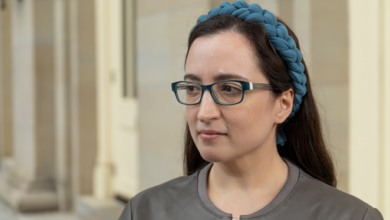Finding substitute teachers a challenge for N.S. schools, NSTU president says
It can be difficult to find a substitute for a good teacher.
“Teaching is a beautiful profession when it’s supported, and we just have to do more to support those folks,” said Ryan Lutes, a high school math teacher and a 15-year veteran of the teaching profession who took over as president of the Nova Scotia Teachers Union last summer.
“We don’t believe there are enough now,” Lutes said of available substitute teachers to replace full-time teachers who can’t answer the bell because of illness or other reasons.
“We don’t think anything has changed from last year when there were significant issues, especially heightened during the cold and flu season, but not exclusive to that. There are schools that are finding it really challenging to get the right number of substitute teachers in the building.”
Nearly 10,000 NSTU members will return to the province’s 370 public schools Friday in preparation for the arrival of more than 129,000 students on Tuesday and Wednesday.
“There would be times that despite a school’s best effort, they might not be able to find a substitute. That most often happens when there is a last-minute absence that’s unexpected. In cases such as that, schools look internally and resolve those issues to make sure students have a teacher in front of them.”
Chris Boulter, Education and Early Childhood Development Department
“Right now, we have approximately 2,600 substitutes across Nova Scotia,” said Chris Boulter, executive director of education, innovation, programs and services with the provincial Education and Early Childhood Development Department.
“That number is pretty consistent with pre-COVID numbers. What we do know is not all substitutes work the full complement of days. Part of what we’re doing right now is … to explore how do we better support the 2,600 or so substitute teachers we have to ensure that we encourage them to substitute as many days as possible.”
Boulter said the department has had good feedback from a large-scale survey conducted last spring in partnership with the NSTU and the Public School Administrators Association of Nova Scotia.
“Our plans moving forward are really focused on how do we ensure when substitutes go to schools, they feel welcome, included, have a great experience and want to come back more,” he said.
The pool of substitutes is made up primarily of retired teachers and teachers with bachelor of education degrees who are substituting because they can’t find a permanent classroom, along with a limited number of permit teachers who have a bachelor’s degree but not in education.
Boulter said there is no limit on the number of days that a substitute teacher can take his or her place in front of a classroom and the 69.5-day ceiling for retirees to substitute has been extended to 99.5 days without negative impact on their pensions.
There are 195 days in the school teaching calendar.
Each of the seven regional centres for education and the francophone school board has a database that includes all available substitute teachers.
“When a teacher is unable to attend work due to illness, they inform their administration and enter the absence in AESOP, our absence management platform,” said Lindsey Bunin, communications officer with the Halifax Regional Centre for Education;
“The platform creates an absence, and substitute teachers can log in and accept fill-in assignments. In the event of absences, the administrative team at each school ensures classes are covered and student supervision is provided.”
Bunin said the HRCE has more than 800 substitutes available for work as the school year commences, with new candidates added regularly, especially early in the term.
“Every one of those unfilled absences is a substitute teacher that wasn’t found, but also somewhere in the system, students lost out on some support that they were supposed to have. … That time or resource is being taken from somewhere else in the system. It’s robbing Peter to pay Paul to keep the doors of our schools open.”
Ryan Lutes, president of the Nova Scotia Teachers Union
Boulter said there are instances when a substitute is simply not available.
“There would be times that despite a school’s best effort, they might not be able to find a substitute,” Boulter said. “That most often happens when there is a last-minute absence that’s unexpected. In cases such as that, schools look internally and resolve those issues to make sure students have a teacher in front of them.”
Lutes said there were thousands of those “unfilled absences” during the last school year in Nova Scotia.
“What has to happen in those situations, no substitute to fill in, is they are pulling a teacher oftentimes who should be with a smaller group of students, maybe at-risk students or students who need support with literacy or math, pulling that teacher from that small group to be the teacher in front of the classroom,” he said.
“Every one of those unfilled absences is a substitute teacher that wasn’t found, but also somewhere in the system, students lost out on some support that they were supposed to have.”
It could also deprive full-time teachers of class preparation or marking time because they are pulled into a substitute role.
“That time or resource is being taken from somewhere else in the system,” Lutes said. “It’s robbing Peter to pay Paul to keep the doors of our schools open.”
He said there are layered reasons why there are not enough teachers and substitutes.
“Over the last 15 to 20 years, society has changed, gotten more complicated, and the classroom has gotten more complicated, and I don’t think resources have kept up, so the profession itself has become less attractive to folks,” Lutes said.
Pay level issue
Young adults are not flocking to the teaching profession, he said, but the trend is instead for a signicant number of teachers to leave the profession within five years of starting to teach, for a variety of reasons.
“One of the other things I hear often from substitute teachers is the pay just simply doesn’t make it work,” Lutes said.
“If you substitute pretty much every day of the school year, you can make somewhere between $32,000 and $35,000 a year, which wasn’t a lot of money before the affordability crisis and certainly isn’t a lot of money now. I know that’s keeping some people out of the profession and it’s kept some retirees who would come back on as substitute, but they won’t come back and substitute for that amount of money.”
Lutes said substitute teacher pay in Nova Scotia is the lowest in the region, likely extrapolating into the lowest of any Canadian jurisdiction.
He said the union advocates on behalf of non-retiree substitute teachers and they are considered members of the union on the days they work.
“They are a very important type of teacher because oftentimes they are entry-level teachers, new graduates who are coming in to gain some experience and hopefully get full-time positions,” Lutes said. “With the affordability crisis, they are a group of teachers that we hear from often, saying, ‘I can’t do this, it’s better for me to work outside education than it is to work as a substitute teacher,’ even though that’s what they want to be doing.”
Lutes referenced an article from Quebec last week that reported 8,000 teaching vacancies in that province. He said most full-time teaching positions are filled in Nova Scotia, but the Quebec example could be a harbinger of future teacher shortages here.
“That’s where we could get to if we don’t come up with a solution or at least attempt a solution,” he said.
The solution the teachers union has been advocating for more than a year is for government to develop a teacher recruitment and retention plan.
“We want to be a partner in that,” Lutes said. “It has to make the profession more attractive, it has to make the workload better. A word I hear often from teachers is that with the supports in the system, their job is unsustainable.”
Lutes said the plan should look at working conditions for teachers, learning conditions for students, financial compensation and “all of the factors to make the system better so that kids and teachers can be supported.”




